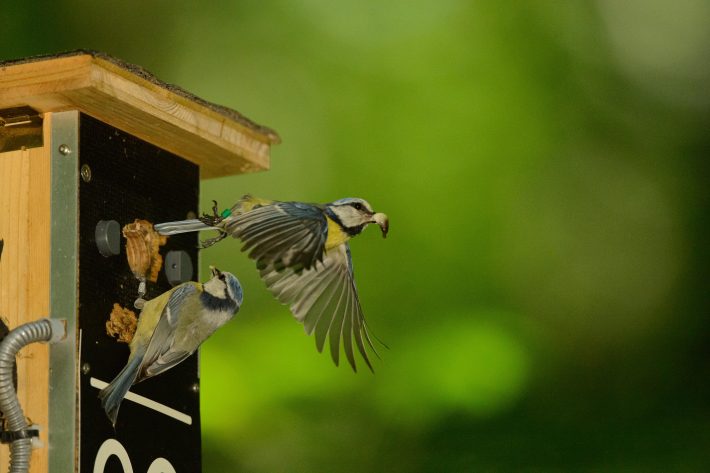The loss of a parent is the most common cause of brood failure in blue tits
Max Planck Institute for Ornithology press release
Complete brood failure in blue tits is almost always associated with the sudden and permanent disappearance of one of the parents. Peter Santema and Bart Kempenaers from the Max Planck Institute for Ornithology in Seewiesen show in their study that the remaining parent substantially increased its effort to raise at least some of the chicks, which turned out to be successful in two thirds of the nests.
Single parent males generally do worse, probably because they are not able to keep their chicks warm. Their findings are published today in the Journal of Animal Ecology.

Apart from being a popular garden feeder visitor, blue tits have been the focus of much research on the causes and consequences of variation in reproductive success. Blue tits typically lay between 8-15 eggs, of which a varying number of young will survive to leave the nest. In some nests, however, all the offspring die before they are old enough to leave the nest.
Finding out what causes these cases of complete brood mortality has proven challenging. Does one parent leave all the care to its mate? Can a single parent not cope with the demands? Do both parents decide to desert their brood? To find out, we need to know exactly when parents stop bringing food and when the offspring perish.
Therefore, Peter Santema and Bart Kempenaers from the Max Planck Institute for Ornithology in Seewiesen equipped all adult blue tits in their study site with a tiny, passive integrated transponder.
They also designed nestboxes with a built-in, automated monitoring system that recorded every visit of a transpondered bird throughout the entire year. With this system, they could analyse all parental visits of 277 nestboxes and determine when a parent was last present at the nest. In case of sudden parental disappearance, they also measured how often the remaining parent visited, both before and after the disappearance of its partner.
Of the 684 nests analysed over seven years, 13 percent suffered complete brood failure. The researchers found that in almost all of these nests, one of the parents had disappeared while the young were still alive.
“This raises the question whether one of the parents deserted and left all the care to its partner, or whether the parents were exhausted and simply gave up,” says Bart Kempenaers, who was leading the study.
Both scenarios are unlikely, because the researchers found that – with one exception – all birds that had disappeared were never observed again in the study area.
Moreover, their nest visit rates were normal up to the moment of disappearance, suggesting that these were otherwise healthy individuals.
“All the evidence suggests that death by predation is the most likely cause for the disappearance of a parent”, says Peter Santema, first author of the study.
The constant flying to and from the nest makes them vulnerable to predation by aerial predators, in particular the sparrowhawk.
However, disappearance of one parent does not necessarily mean the end for all young in the brood. In more than two thirds of the cases where one parent disappeared early on, at least some of the nestlings reached the ripe old age of 21 days, when they are fully grown and leave the nest. The likelihood of success was higher when the male disappeared.
“Nestlings cannot thermoregulate before their feathers are developed and only females have the ability to keep them warm”, says Peter Santema.
This might explain why males were overall less successful as single parents than females.
In other cases, the remaining parent seemed unable to care for the brood on its own. After they became single parents, both males and females substantially increased their nest visit rates, but in unsuccessful broods, visit rates gradually declined. This suggests that all single parents tried to raise the brood, but that some could not keep up with the high demand.
As blue tits breed only once a year and are short-lived, the prospects of future reproductive opportunities are low. Hence, it seems unlikely that parents would desert their nestlings by choice.
In contrast to nests that suffered complete brood failure, nests where only part of the offspring died usually had both parents still present. Factors other than the loss of a parent, for instance food shortage or disease, must therefore be responsible for these cases.
“Our findings highlight that partial and complete brood morality in blue tits have different causes”, concludes Bart Kempenaers.
Read the full article (freely available for a limited time):
Santema P, Kempenaers B. Complete brood failure in an altricial bird is almost always associated with the sudden and permanent disappearance of a parent. J Anim Ecol. 2018;00:1–12. DOI: 10.1111/1365-2656.12848
Media contact (only via email due to field studies in June):
Prof. Dr. Bart Kempenaers, Max Planck Institute for Ornithology, Seewiesen, Email: b.kempenaers@orn.mpg.de
Like what we stand for?
Support our mission and help develop the next generation of ecologists by donating to the British Ecological Society.